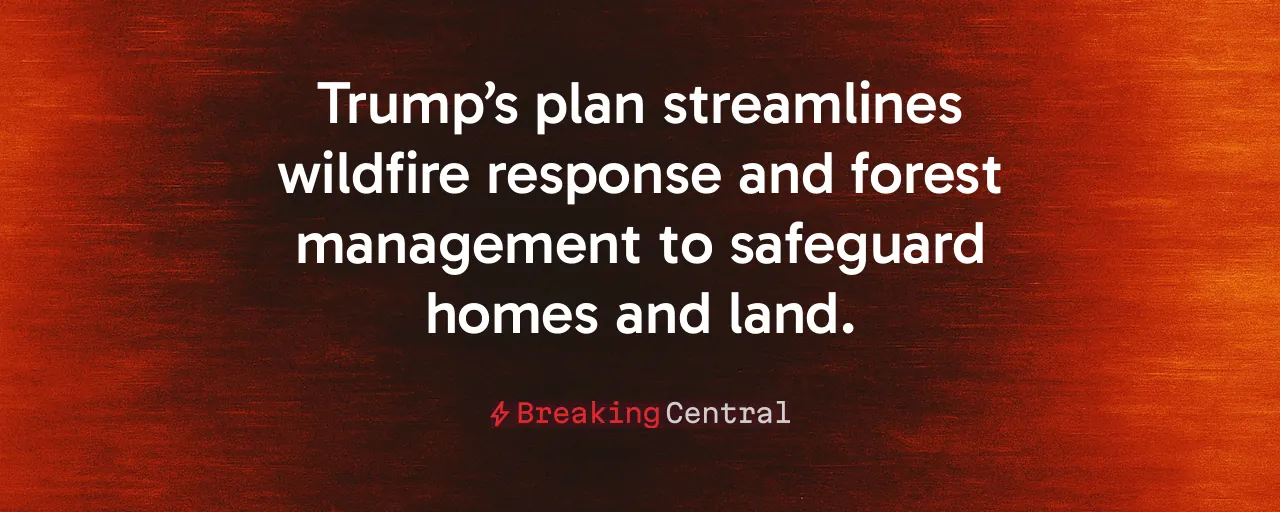Flames Threaten Our Heartland
Wildfires are ravaging America's landscapes and livelihoods. Last year, 8.9 million acres burned, and early 2025 saw Los Angeles lose 16,000 homes and businesses. Families watched their dreams turn to ash. President Trump's Executive Order, signed June 12, 2025, confronts this crisis head-on. It streamlines federal action, cuts through red tape, and equips local communities to fight back. This is about protecting our land and our people with real solutions.
America's forests are overgrown, primed for disaster by years of neglect. U.S. Department of Agriculture Secretary Brooke Rollins and Interior Secretary Doug Burgum warned Trump of the urgent need for change. With 63 million acres of national forests at severe risk, delay is not an option. Rural towns shouldn't live under the constant threat of flames when we have the knowledge and tools to act decisively.
This fight transcends politics. It's about survival. The Trump administration's plan focuses on practical forest management, thinning overgrowth, expanding timber harvests, and upgrading firefighting technology. Forest Service firefighters like James Melonas and Charlie Palermo, present at the signing, embody the courage behind this effort. These brave men and women deserve a system that supports their mission to save lives and land.
The stakes are personal. Every charred acre represents a lost home, a shuttered business, or a scarred community. The administration's approach honors the people who depend on these forests, from loggers to homeowners. Why let bureaucracy stand in the way of protecting our nation's heartland? The time for action is now, and Trump's order sets the tone.
History shows what happens when we ignore the problem. The 1990s Northwest Forest Plan slashed timber harvests by 80 percent, leaving forests dense and rural economies gutted. Fuel buildup turned manageable fires into megafires. We can't repeat those mistakes. This executive order charts a smarter path forward.
Clearing the Path to Safety
The Executive Order, Empowering Commonsense Wildfire Prevention and Response, delivers results. It unifies federal fire programs, embraces technology like AI fire detection, and eliminates delays in permitting. Studies confirm that thinning forests and controlled burns can reduce wildfire intensity by up to 72 percent. Yet, endless environmental reviews under the National Environmental Policy Act have stalled projects, sometimes for decades. Trump's order demands efficiency.
The Forest Service's Emergency Situation Determination spans 112.6 million acres, directing managers to prioritize timber harvests and simplify approvals. This approach tackles fire risk while reviving rural economies. The administration aims to increase timber output by 25 percent, creating jobs and strengthening communities hit hard by mill closures. The $23 million Hazardous Fuels Transportation Program moves dead wood to mills and biomass plants, turning risk into opportunity.
Environmental groups argue that logging harms ecosystems and that climate change is the real driver. Their stance overlooks critical evidence. Unmanaged forests fuel catastrophic fires. Healthy forests resist such blazes. The 2003 Healthy Forests Restoration Act demonstrated that thinning saves forests. States like Washington, treating 900,000 acres under its forest health plan, prove that active management works. Why cling to policies that leave our forests vulnerable?
Strengthening Local Resolve
Effective wildfire defense starts with communities. The Trump plan bolsters partnerships with state, tribal, and local responders. With 17,000 federal firefighters and 13,000 local personnel geared up for 2025, coordination is vital. Programs like the Community Wildfire Defense Grants empower towns to fortify homes and clear brush. This approach trusts local knowledge to protect local land.
Good Neighbor Authority agreements, like those in Washington, show how states and federal agencies can share resources to treat forests faster. These collaborations cut costs and build resilience. Some advocate for centralized climate policies, blaming drought for escalating fires. But drought alone doesn't explain the 2025 Los Angeles megafire. Decades of fuel buildup turned a spark into a catastrophe. Local action, backed by federal support, addresses the root causes.
Building a Resilient Future
This strategy extends beyond firefighting, it embraces prosperity. Timber sales fund forest treatments, easing taxpayer costs. Biomass facilities and cross-laminated-timber plants transform low-value wood into energy and construction materials, reducing reliance on foreign imports. Rural America gains jobs and stability while forests become safer. This is practical innovation at its best.
Alternatives, like restrictive regulations or overreliance on prescribed burns, fall short. Controlled burns face tight schedules, smoke restrictions, and complex permits. With fire seasons now 78 days longer than in the 1970s, we need faster solutions. The administration's 96 percent firefighter staffing and year-round readiness show real commitment. Waiting for ideal conditions isn't an option when flames are at the door.
Trump's vision, outlined in briefings with Secretaries Rollins, Burgum, and Noem, balances forest health, economic growth, and community safety. The plan is grounded in reality, reflecting a practical approach. Will we protect our forests and towns with bold action, or let indecision fuel more destruction? America deserves leaders who choose strength, and this executive order delivers exactly that.
